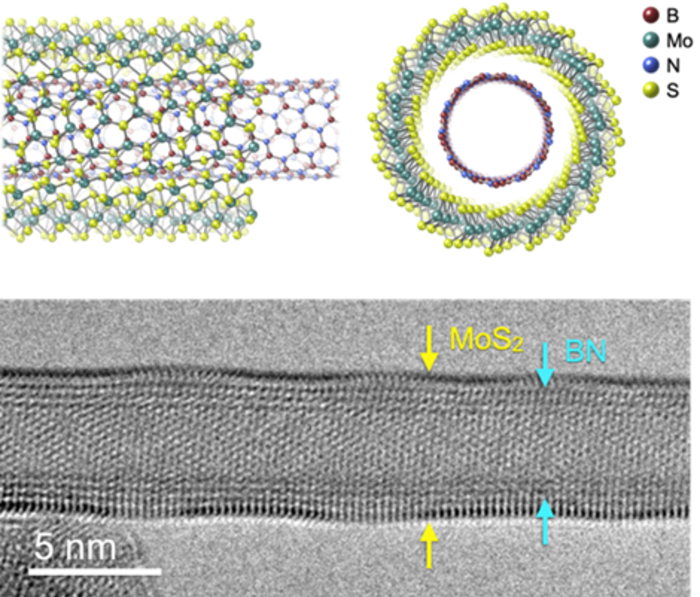With the help of a surfactant, scientists from Tokyo Metropolitan University dispersed insulating boron nitride nanotubes and coated them onto surfaces without the need for bundling.

Chemical vapor deposition of molybdenum disulfide on a well-isolated boron nitride nanotube creates a coaxial nanotube structure. Image Credit: Tokyo Metropolitan University.
The scientists showed that heat treatment could eliminate the surfactant to expose clean nanoscale templates. Then, chemical vapor deposition could form coaxial nanotubes on the template using a variety of materials. The capability of coating nanotubes onto “inert” insulating structures provides researchers unparalleled access to the unique features of new nanotube materials.
Thanks to the innovations in nanotechnology, materials scientists are now able to easily obtain nanotubes and nanosheets. But analyzing them in isolation is quite challenging. As they frequently come bundled or aggregated, it is complicated to target the unusual electronic and optical properties that come from their compact dimensionality.
Studies have shown that nanotube materials can be grown on the surface of a carbon nanotube, delivering well-separated structures that could possibly be categorized. But carbon nanotubes possess conducting properties and robustly absorb light, making it challenging to distinguish the optical and electrical features of the coated material from those of the primary nanotube.
Currently, a team guided by Assistant Professor Yusuke Nakanishi, Associate Professor Yasumitsu Miyata, and Assistant Professor Yohei Yomogida from Tokyo Metropolitan University has utilized insulating boron nitride (BN) nanotubes instead as templates for forming nanotubes.
This is no easy endeavor: BN nanotubes are extremely sticky. Though they can be spread with a surfactant, which helps to keep the tubes separated, it was not comprehensible if the surfactant could be eliminated to expose a clean template.
At present, the researchers have successfully found a surfactant that does not adhere to the tubes; they also enhanced a heat treatment under vacuum, which delivers clean, well-isolated insulating nanotube templates.
A variety of materials could be coated onto the templates with the help of chemical vapor deposition. The new tube wraps around the primary BN tubes, creating something that resembles a nanoscale coaxial cable.
Significantly, because BN is an insulating material, the electrical properties of any materials coated can be explored in unparalleled depth. This comprises a property called chirality, the “handedness” in the structure of the atoms in the nanotube, which induces an entire range of unusual electronic properties.
In theory, the researchers believe that their “nano-test-tubes” can be used to template the formation of an entire range of diverse materials. They have already succeeded with carbon and molybdenum disulfide, with the scope for several more.
Along with the electrical and optical inertness of their BN template, their new system promises material discovery as well as unconstrained access to their unusual physicochemical properties.
This work was supported by the JST FOREST Program Grant Number JPMJFR213X, JSPS KAKENHI Grant Numbers JP19H02543, JP19K15392, JP20H00220, JP20H02572, JP20H02573, JP20H02605, JP20KK0114, JP21H05232, JP21H05234, JP22H00280, JP22H00283, JP22H01911, JP22K04886, JP22H04957, JP22H05468, and JP22H05469, and JST CREST Grant Numbers JPMJCR17I5, JPMJCR20B1, and JPMJCR20B5.
Journal Reference
Furusawa, S., et al. (2022) Surfactant-Assisted Isolation of Small-Diameter Boron-Nitride Nanotubes for Molding One-Dimensional van der Waals Heterostructures. ACS Nano. doi.org/10.1021/acsnano.2c06067.